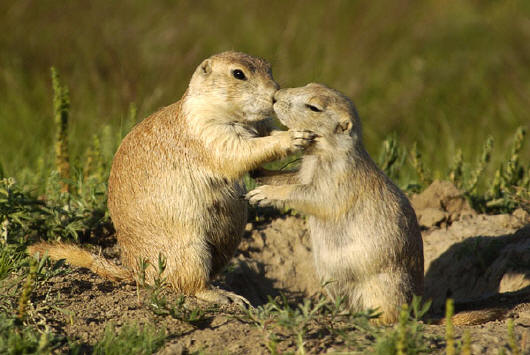A Kiss To Build A Dream On...

OK, too much death & taxes today; it's time for some makin' out.
It's In His Kiss...
The Department of Exhaustive Research of the Obvious at the University at Albany shows that information conveyed by a kiss can have profound consequences for romantic relationships, and can even be a major factor in ending one.
In a recently published article a few evolutionary psychologists reveal that many college students have found themselves attracted to someone, only to discover after they kissed them for the first time that they were no longer interested. In other words, while many forces lead two people to connect romantically, the kiss, particularly the first kiss, can be a deal breaker.
The University at Albany study also found sex differences in the importance and type of kissing. Males tended to kiss as a means to an end -- to gain sexual favours or to reconcile. In contrast, females kiss to establish and monitor the status of their relationship, and to assess and periodically update the level of commitment on the part of a partner. I'm always down for a status check by the way.
According to the ground breaking study, kissing between sexual or romantic partners occurs in more than 90% of human cultures. Some non-human animals, such as common chimpanzees and bonobos (dwarf chimpanzees), appear to engage in kissing-like behaviours as well. Although kissing is a widespread practice among humans, few scientists have attempted to assess the adaptive significance of kissing behaviour.
Kissing is part of an evolved courtship ritual," said evolutionary psychologist Gordon Gallup (no relation to Simon). "When two people kiss there is a rich and complicated exchange of information involving chemical, tactile, and postural cues. This may activate evolved mechanisms that function to discourage reproduction among individuals who are genetically incompatible." Yeah, what he said.
According to the researchers, not only do females place more emphasis on kissing, but most would never engage in sex sans kissing. Females were more likely than males to insist on kissing before a sexual encounter, and more likely to emphasize the importance of kissing during and after sexual encounters as well. By comparison, males said they would be happy to have sex without kissing (ha!), and far more males than females expressed a willingness to have sex with someone who was not a good kisser.
tigers exhibit "kissing-like behaviours" - i love that term
Males, however, were more likely than females to initiate open mouth kissing and kissing with tongue contact. The researchers speculate that the exchange of saliva during kissing may have biological consequences in its own right. Male saliva contains measurable amounts of the sex hormone testosterone which can affect libido.
The authors conclude that the study provides evidence that romantic kissing evolved as an adaptive courtship strategy that functions as a mate-assessment technique, a means of initiating sexual arousal and receptivity, and a way of maintaining a bonded relationship.
So how does one gesture come to signify affection, celebration, grief, comfort and respect, all over the world? No one knows for sure, but anthropologists think kissing might have originated with human mothers feeding their babies much the way birds do. After the babies learned to eat solid food, their mothers may have kissed them to comfort them or to show affection.
Black-tailed Prairie Dogs get it on, bang a gong!
In this scenario, kissing is a learned behaviour, passed from generation to generation. We do it because we learned how to from our parents and from the society around us. There's a problem with this theory, though: women in a few modern indigenous cultures feed their babies by passing chewed food mouth-to-mouth. But in some of these cultures, no one kissed until Westerners introduced the practice. Hmmmmmm. Read more Sheldrake.
Other researchers believe instead that kissing is instinctive. They use bonobo apes, which are closely related to humans, to support this idea. Bonobos kiss one another frequently. Regardless of sex or status within their social groups, bonobos kiss to reduce tension after disputes, to reassure one another, to develop social bonds and sometimes for no clear reason at all. Some researchers believe that kissing primates prove that the desire to kiss is instinctive.
Several other animal species have behaviours that resemble kissing: Many mammals lick one another's faces, birds touch one another's bills and snails caress one another's antennae. In some cases, the animals are grooming one another rather than kissing. In others, they're smelling scent glands that are located on faces or in mouths... pheromones!
Regardless, when animals touch each other in this way, they're often showing signs of trust and affection or developing social bonds. Scientists don't entirely agree on whether kissing is learned or instinctive. There's support for both arguments, just as there's support for the different theories of why people started doing it in the first place.
People in some cultures rub one another's noses or cheeks rather than, or in addition to, kissing. Anthropologists theorize that this "Eskimo kiss" grew from people smelling one another's faces much the way animals do.
While researchers aren't exactly sure how or why people started kissing, they do know that romantic kissing affects most people profoundly. The Kinsey Institute describes a person's response to kissing as a combination of three factors:
The Effects of Kissing
Your psychological response depends on your mental and emotional state as well as how you feel about the person who is kissing you. Psychologically, kissing someone you want to kiss will generally encourage feelings of attachment and affection. If you're kissing someone you don't like, or you're kissed against your will, your psychological response will be completely different.
Your body physically reacts to being kissed. Most people like to be touched, and that's part of your body's response to kissing. But kissing also affects everything from your blood to your brain. We'll look at your body's biological reactions to kissing in detail in a later section.
The culture in which you grew up plays a big part in how you feel about kissing. In most Western societies, people are conditioned to, look forward to and enjoy kissing. The behaviour of the people around you, depictions in the media and other social factors can dramatically affect how you respond to being kissed.
These factors play a part in all kisses, not just those that are romantic in nature. In other words, when a mother kisses her child's bruise to make it feel better, psychological, physical and social factors play a part in both people's reactions. The same is true when friends kiss as a greeting, worshippers kiss religious symbols or siblings kiss and make up after an argument. Even though some kisses are platonic and others are romantic, they generally have one thing in common - they are inspired by and tend to inspire feelings we think of as positive.
Regardless of exactly how people got the idea to kiss or what they mean when they do it, anthropologists are pretty sure that people started kissing thousands of years ago a/k/a back in the day.
Historians really don't know much about the early history of kissing. Four Vedic Sanskrit texts, written in India around 1500 B.C., appear to describe people kissing. This doesn't mean that nobody kissed before then, and it doesn't mean that Indians were the first to kiss. Artists and writers may have just considered kissing too private to depict in art or literature.
"Kiss," by Francesco Hayez in the 19th century. Before the 19th century, kisses did not appear frequently in Western artwork.
After its first mention in writing, kissing didn't appear much in art or literature for a few hundred years. The Indian epic poem "Mahabharata" describes kissing on the lips as a sign of affection. The "Mahabharata" was passed down orally for several hundred years before being written down and standardized around 350 A.D. The Indian religious text "Vatsyayana Kamasutram," or the "Kama Sutra," HEY NOW! also describes a variety of kisses. It was written in the 6th century A.D. Anthropologists who believe that kissing is a learned behaviour theorize that the Greeks learned about it when Alexander the Great invaded India in 326 B.C.
There aren't many records of kissing in the Western world until the days of the Roman Empire. Romans used kisses to greet friends and family members. Citizens kissed their rulers' hands. And, naturally, people kissed their romantic partners. The Romans even came up with three different categories for kissing: Osculum was a kiss on the cheek, Basium was a kiss on the lips and Savolium was a deep kiss.
Naturally, the Romans also started several kissing traditions that have lasted to the present day. In ancient Rome, couples became betrothed by kissing passionately in front of a group of people. This is probably one reason why modern couples kiss at the end of wedding ceremonies. Additionally, although most people today think of love letters as "sealed with a kiss," kisses were used to seal legal and business agreements. Ancient Romans also used kissing as part of political campaigns. However, several "kisses for votes" scandals in 18th century England led - in theory - to candidates kissing only the very young and very old.
Kissing played a role in the early christian church. Christians often greeted one another with an osculum pacis, or holy kiss. According to this tradition, the holy kiss caused a transfer of spirit between the two people kissing. Most researchers believe the purpose of this kiss was to establish familial bonds between the members of the church and to strengthen the community.
Until 1528, the holy kiss was part of catholic mass. In the 13th century, the catholic church substituted a pax (peace) board, which the congregation kissed instead of kissing one another. The Protestant Reformation in the 1500's removed the kiss from Protestant services entirely. The holy kiss doesn't typically play a role in modern christian religious services, although some christians do kiss religious symbols, including the Pope's ring.
Although few religions currently incorporate the holy kiss, kissing remains prevalent throughout Western culture. Nowadays, people kiss in many contexts and for many reasons.
But not all kisses have been happy events. Works of literature like "Romeo and Juliet" have portrayed kisses as dangerous or deadly when shared between the wrong people. Some folklorists and literary critics view vampirism as symbolic of the physical and emotional dangers that can come from kissing the wrong person.
Most cultures around the world kiss today, but many have different views about when and where kissing is appropriate. In the 1990's, several news articles reported a trend of young people kissing in public in Japan, where kissing had traditionally been viewed as a private activity.
One of the Western world's most famous kisses is the kiss Judas Iscariot used to betray Jesus shortly before his crucifixion. This kiss had an influence on Christian spiritual practices. Early church sects omitted the holy kiss - or abstained from kissing entirely - on Maundy Thursday. Maundy Thursday is the Thursday before Easter and the day used to commemorate the Last Supper, after which Judas betrayed Jesus in the Garden of Gethsemane.
The timeless love betwixt Sir Lancelot of the Lake and Queen Guinevere, the wife and queen of King Arthur, became the most popular and famous tale of the "Arthurian legend". The Matter of Britain or the Arthurian legend is a name given collectively to the legends that concern the Celtic and legendary history of the British Isles, especially those focused on King Arthur and the knights of the Round Table
Take a look at the anatomy and physiology behind kissing: The Anatomy of a Kiss by Tracy V. Wilson.


No comments:
Post a Comment